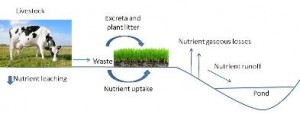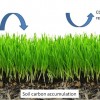 Many forage-based livestock production systems in Florida are characterized by extensive grazing with minimal inputs of commercial fertilizer and supplemental feed. In these systems, adequate soil fertility conditions are essential to sustain forage production. If nutrients become deficient, pasture and animal performance is reduced, and the economic returns of livestock operations may decline. This 3-page fact sheet discusses the different nutrient pathways in grazing pastures to help producers better understand how to promote nutrient cycling and pasture sustainability. Written by Maria L. Silveira, Joao M. B. Vendramini, Hiran M. da Silva, and Mariana Azenha, and published by the UF Department of Soil and Water Science, January 2013.
Many forage-based livestock production systems in Florida are characterized by extensive grazing with minimal inputs of commercial fertilizer and supplemental feed. In these systems, adequate soil fertility conditions are essential to sustain forage production. If nutrients become deficient, pasture and animal performance is reduced, and the economic returns of livestock operations may decline. This 3-page fact sheet discusses the different nutrient pathways in grazing pastures to help producers better understand how to promote nutrient cycling and pasture sustainability. Written by Maria L. Silveira, Joao M. B. Vendramini, Hiran M. da Silva, and Mariana Azenha, and published by the UF Department of Soil and Water Science, January 2013.
http://edis.ifas.ufl.edu/ss578
Tag: Hiran M. da Silva
Carbon Sequestration in Grazing Land Ecosystems (SL373/SS574)
 Native and improved pastures play an important role in sequestering carbon from the atmosphere. Because of the relatively high sequestration rates and extensive area, grazing land represents an important component of terrestrial carbon dioxide (CO2) offset and is a significant sink for long-term carbon sequestration and greenhouse gas mitigation. This 4-page fact sheet contains information for stakeholders, students, scientists, and environmental agencies interested in enhancing ecosystems services provided by grazing lands. Written by Maria Silveira, Ed Hanlon, Mariana Azenha, and Hiran M. da Silva, and published by the UF Department of Soil and Water Science, September 2012.
Native and improved pastures play an important role in sequestering carbon from the atmosphere. Because of the relatively high sequestration rates and extensive area, grazing land represents an important component of terrestrial carbon dioxide (CO2) offset and is a significant sink for long-term carbon sequestration and greenhouse gas mitigation. This 4-page fact sheet contains information for stakeholders, students, scientists, and environmental agencies interested in enhancing ecosystems services provided by grazing lands. Written by Maria Silveira, Ed Hanlon, Mariana Azenha, and Hiran M. da Silva, and published by the UF Department of Soil and Water Science, September 2012.
http://edis.ifas.ufl.edu/ss574